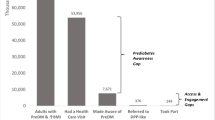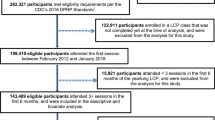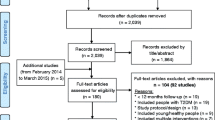Abstract
The evidence base derived from the research literature has clearly established that type 2 diabetes mellitus may be prevented or delayed through pharmacological interventions and, most efficaciously, through lifestyle interventions. Unfortunately, efforts to translate the research results into programs that may be applied to the clinical or healthcare system setting are lacking. The purpose of this article is 3-fold: (i) to briefly review the results of the major trials conducted in the area of type 2 diabetes; (ii) to outline an approach that may guide the design and development of type 2 diabetes prevention programs for clinical care; and (iii) to present a protocol that may support the process of implementation in the practice setting.
The literature review clearly delineates critical type 2 diabetes prevention program outcomes, i.e. modest weight loss, dietary changes, an increase in physical activity level and, in the case of pharmacological interventions, good adherence to medication regimens. Guided by evidence-informed approaches to translation, this article outlines a set of critical program design principles that guide the development of type 2 diabetes prevention programs, and are systematically included and recognized in the programs; these principles are termed the ‘4Ss’: (i) effect size; (ii) program scope; (iii) scalability; and (iv) long-term sustainability in the real-world setting.
Based on additional literature that addresses operational feasibility and principles of design and evaluation, this paper describes a protocol that may help healthcare systems and care delivery settings design such prevention programs and successfully document desired impacts that are meaningful to their customers. The protocol is designed to include the total membership of a healthcare system and it systematically allows for the identification and stratification of the risk of developing type 2 diabetes. Individuals are assigned to one of three risk strata: (i) low risk of developing type 2 diabetes; (ii) high risk of developing type 2 diabetes; or (iii) active disease (already diagnosed with type 2 diabetes). The high-risk group is subsequently invited to participate in risk-reduction strategies that are designed to reduce the incidence of type 2 diabetes.



Similar content being viewed by others
References
Eriksson KF, Lindgärde F. Prevention of type 2 (non-insulin-dependent) diabetes mellitus by diet and exercise: the 6-year Malmö feasibility study. Diabetologia 1991; 34: 891–8
Pan XR, Li GW, Hu YH, et al. Effects of diet and exercise in preventing NIDDM in people with impaired glucose tolerance: the Da Qing IGT and Diabetes Study. Diabetes Care 1997; 20: 537–44
Tuomilehto J, Lindström J, Erksson J, et al. Prevention of type 2 diabetes mellitus by changes in lifestyle among subjects with impaired glucose tolerance. N Engl J Med 2001; 344: 1343–50
Knowler WC, Barret-Connor E, Fowler SE, et al. Reduction in the incidence of type 2 diabetes with lifestyle intervention or metformin. N Engl J Med 2002; 346: 393–403
Chiasson JL, Josse RG, Gomis R, et al. Acarbose for prevention of type 2 diabetes mellitus: the STOP-NIDDM randomized trial. Lancet 2002; 359: 2072–7
Buchanan TA, Xiang AH, Peters RK, et al. Preservation of pancreatic beta-cell function and prevention of type 2 diabetes by pharmacological treatment of insulin resistance in high-risk Hispanic women. Diabetes 2002 Sep; 51(9): 2796–803
Björntorp P. Metabolic implications of body fat distribution. Diabetes Care 1991; 14: 1132–43
Kjos SL, Peters RK, Xiang A, et al. Predicting future diabetes in Latino women with gestational diabetes: utility of early post-partum glucose tolerance testing. Diabetes 1995; 44: 586–91
American Diabetes Association and National Institute of Diabetes, Digestive and Kidney Diseases. The prevention or delay of type 2 diabetes. Diabetes Care 2002; 25(4): 742–9
Dowse GK, Zimmet PZ, Gareebo KG, et al. Abdominal obesity and physical activity are risk factors for NIDDM and impaired glucose tolerance in Indian, Creole, and Chinese Mauritians. Diabetes Care 1991; 14: 271–82
Albright A, Franz M, Hornsby G, et al. ACSM position stand: exercise and type 2 diabetes. Med Sci Sports Exerc 2000; 32: 1345–60
Ivy JL, Zderic TW, Fogt DL. The prevention and treatment of non-insulindependent diabetes mellitus. Exerc Sports Sci Rev 1999; 27: 1–35
Kriska AM, Blair SN, Pereira MA. The potential role of physical activity in the prevention of non-insulin-dependent diabetes mellitus: the epidemiological evidence. Exerc Sports Sci Rev 1994; 22: 121–43
Mokdad AH, Bowman BA, Ford ES, et al. The continuing epidemics of obesity and diabetes in the United States. JAMA 2001; 286: 1195–200
Azen SP, Peters RK, Berkowitz K, et al. TRIPOD (TRoglitazone In the Prevention Of Diabetes): a randomized, placebo-controlled trial of troglitazone in women with prior gestational diabetes mellitus. Control Clin Trials 1998; 19: 217–31
The Diabetes Prevention Program. Design and methods for a clinical trial in the prevention of type 2 diabetes: the Diabetes Prevention Program Research Group. Diabetes Care 1999; 22: 623–34
Pronk NP. Designing and evaluating health promotion programs: simple rules for a complex issue. Dis Manage Health Outcomes 2003; 11(3): 149–57
Glasgow RE, Vogt TM, Boles SM. Evaluating the public health impact of health promotion interventions: the RE-AIM framework. Am J Public Health 1999; 89: 1322–7
The Diabetes Prevention Program (DPP). Description of lifestyle intervention: the Diabetes Prevention Program (DPP) Research Group. Diabetes Care 2002; 25(12): 2165–71
Pronk NP, Wing RR. Physical activity and long-term maintenance of weight loss. Obes Res 1994; 2: 587–99
Sartor G, Schersten B, Carlstrom S, et al. The-year follow-up of subjects with impaired glucose tolerance: prevention of diabetes by tolbutamide and diet regulation. Diabetes 1980; 29: 41–9
O’Connor PJ, Rush WA, Cherney LM, et al. Screening for diabetes mellitus in high-risk patients: cost, yield, and acceptability. Eff Clin Pract 2001; 4: 271–7
Lindström J, Tuomilehto J. The diabetes risk score: a practical tool to predict type 2 diabetes risk. Diabetes Care 2003; 26: 725–31
Pearson TL, Pronk NP, Tan AW, et al. Identifying individuals at risk for the development of type 2 diabetes mellitus. Am J Manag Care 2003; 9: 57–66
Engelgau MM, Venkat Narayan KM, Herman WH. Screening for type 2 diabetes. Diabetes Care 2000; 23(10): 1563–80
Pronk NP, Boucher JL, Gehling E, et al. A platform for population-based weight management: description of a health plan-based integrated systems approach. Am J Manag Care 2002; 8: 847–57
Tate DF, Wing RR, Winett RA. Using Internet technology to deliver a behavioral weight loss program. JAMA 2001; 285(9): 1172–7
Disease Management Association of America [online]. Available from URL: http://www.dmaa.org [Accessed 2004 Jun 5]
O’Connor PJ, Rush W, Rardin K, et al. Are HMO members willing to engage in two-way communications to improve health? HMO Pract 1996; 10: 17–9
Pronk NP, Tan AW, O’Connor PJ. Obesity, fitness, willingness to communicate and health care costs. Med Sci Sports Exerc 1999; 31: 1535–43
Pronk NP, O’Connor PJ. Systems approach to population health improvement. J Ambul Care Manage 1997; 20: 24–31
Acknowledgments
The authors gratefully acknowledge grant support from the National Institutes of Health, Bethesda, MD, USA (#RO1 DK 53826-01A1), and the Robert Wood Johnson Foundation, Princeton, NJ, USA (grant #046929). No potential conflicts of interests are noted for any of the authors.
Author information
Authors and Affiliations
Corresponding author
Rights and permissions
About this article
Cite this article
Pronk, N.P., Boucher, J., Jeffery, R.W. et al. Reducing the Incidence of Type 2 Diabetes Mellitus. Dis-Manage-Health-Outcomes 12, 249–258 (2004). https://doi.org/10.2165/00115677-200412040-00005
Published:
Issue Date:
DOI: https://doi.org/10.2165/00115677-200412040-00005




